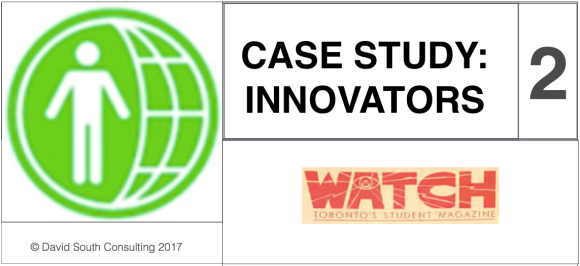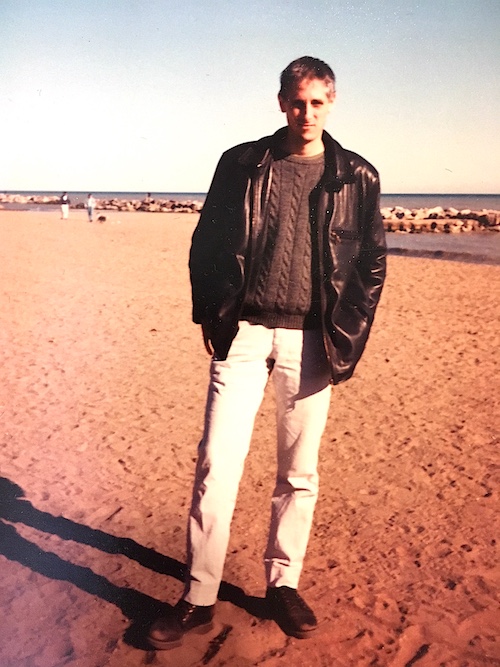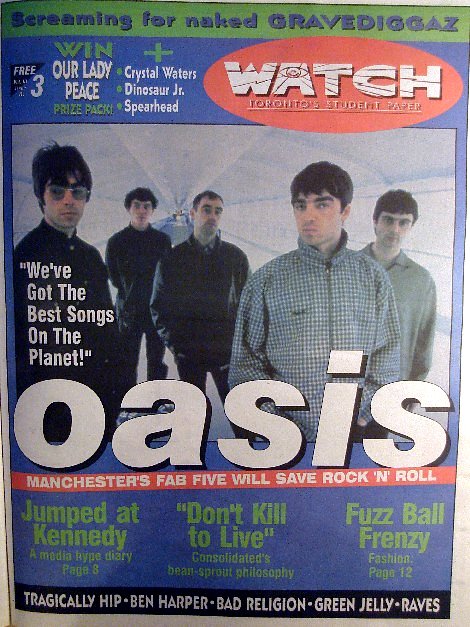
Expertise: Editing, start-ups, youth media, content development, art direction, design and layout, investigative journalism.
Location: Toronto, Ontario, Canada 1994 and 1996
Editor-in-Chief: David South
Click here to view images for this case study: CASE STUDY 2: Watch Magazine | 1994 Images
Abstract
In 1994 I was hired by start-up Youth Culture to be Editor-in-Chief of Toronto’s Watch Magazine, a bi-weekly distributed to the city’s high schools and to all youth hang-outs. In 1996 I was hired again to help with preparing the magazine for its national launch.
About
In 1994, the Internet had not arrived in any great form (though Watch Magazine was on top of its emergence as Internet cafes popped up in the city) and the digital economy was still minimal. There was no such thing as ‘start-up culture’ for youth. There was an urgent need to create opportunity for youth, to create new markets, and to change the business culture of the city of Toronto, which had been hit hard by an economic crash and austerity.
Watch Magazine had had a brief false start prior to my arrival in 1994. The previous format had not worked and the magazine needed a vision and somebody with the experience and dedication to see it through. It was also entering a competitive marketplace for readers, with already existing free magazines capturing most of the advertising spend for youth-oriented marketing in Toronto (though failing to offer a genuine youth content experience as could be found in Europe – the UK especially – at that time). As an example, Toronto lacked sharp and credible coverage of youth popular culture in the early 1990s. Drawing on my extensive experience as a journalist (including at Toronto’s established alternative weekly, Now Magazine) and editor, I assembled a team of youth editors and writers to work on making the content and magazine’s design appealing to the youth demographic in Toronto. The magazine needed to turn a profit in short order and become credible to advertisers, its main source of income (in Canada, 64 per cent of magazine revenues come from advertisers)*. The design and content needed to appeal to a youth audience but work with a tight (but increasing) budget. It was doing this in a tough economy with high unemployment, austerity, business failures, and a generally negative business environment.
By having an actual youth editorial team, Watch Magazine quickly developed an authentically young 1990s voice. The magazine also benefited from its youth team’s ability to spot trends bubbling under the surface ready to explode into mainstream society. As an example, they had this to say on the Internet in a piece on Toronto’s coffee shops, “Some mean places for bean”: “The powers-that-be think we should cocoon in our houses and rent videos, play with the Internet and order in food …”
Youth unemployment was high in the early to mid 1990s in Canada. It reached 19.3 per cent for those 15 to 19 years old in 1993. “It should be noted, however, that youth unemployment relative to that of adults has worsened since the 1990-91 recession (Youth Unemployment in Canada by Kevin B. Kerr, 2000).”
The Canadian economy overall severely contracted and unemployment was at 11.4 per cent by 1993 (Statistics Canada), and as Statistics Canada said, “Because employment recovered at a snail’s pace after the recession of the early 1990s, the decline in the unemployment rate was delayed until 1994”.
As the Bank of Canada also said: “In early 1994, Canada’s economic situation was not that favourable—our economy was facing some rather serious problems. … the recession here was more severe than in the United States.
“Working their way out of these difficulties was disruptive and painful for Canadian businesses. Defaults, restructurings, and downsizings became the order of the day. With all this, unemployment took a long time to recover from the 1990–91 recession …” *
And the media in general could not avoid the crisis. According to the book The Missing News: Filters and Blind Spots in Canada’s Press (Robert A. Hackett and Richard S. Garneau, Canadian Centre for Policy Alternatives, University of Toronto Press 2000), Canada’s media was also in a crisis throughout the 1990s, as declining resources, staff layoffs and media closures reduced the breadth and depth of news coverage.
In less than a year, Watch Magazine had gone from being an unknown quantity, to being a fast-growing and profitable youth publication, significantly increasing its advertising revenue: a key metric for a magazine reliant on this as its main source of income. It had expanded in size and audited distribution and was able to make a move to new digs (the Watch Magazine “crib” – a studio and work space) at innovative “arts-and-culture hub” start-up space 401 Richmond Street in Toronto – at the centre of Toronto’s emerging media and design neighborhood in its former fashion district. All the contributors were high-school-age youth drawn from talent across the city; many had already shown their ability by starting their own publications and media. They gained first-hand experience in investigative journalism skills, business skills in a start-up, and magazine and media production skills.
“… thanks to David [South] for all his hard work on Watch magazine! I learned a lot from him and it was a great experience.” William White
In 1996, I was hired again to help with preparing the content format for Watch’s expansion to a national magazine – further proof of its success as a publication and a business.
* (Bank of Canada: Canada’s Economic Future: What Have We Learned from the 1990s?)
* The Missing News: Filters and Blind Spots in Canada’s Press (Robert A. Hackett and Richard S. Garneau, Canadian Centre for Policy Alternatives, University of Toronto Press 2000)
Brief descriptions of sample issues are below:
Youth Gangs Cover
In 1994, with Canada’s economy still in the doldrums, Watch Magazine exploded into Toronto’s high schools. Staffed by talented youth, it shook up the staid publishing scene and proved young people did have something to say. This first issue still remains relevant, with its exploration of youth gangs and violence in the school system.
Therapy Cover
After its successful launch, Watch Magazine was grabbing readers and getting the attention of advertisers and television. It was time to improve the design and introduce the latest in graphic design software. The results paid off: the magazine looked sharper and quickly ran from its cheeky launch, when we had basically avoided all traditional approaches to a launch (like actually having a designer).
For anoraks out there, this photo shoot with Irish band Therapy took place outside the former Wellesley Hospital emergency department in Toronto. And, yes, that is a genuine restraining ‘straitjacket’ used by psychiatric hospitals to restrain mental health patients.
Digable Planets Cover
By this issue, Watch had hit its stride: we were the first to seriously review the ballooning zine culture, get immersed in the rave and late-night party scene, and dig deep into “chopsocky world”: Hong Kong and Asian film fans. But “Hip-Hop Comb-munism”? What were we thinking?
It was also the biggest issue to date.
Beck Cover
Highly talented Beck gave Watch his eloquent thoughts on the media’s infatuation with Generation X and how it always desperately needs to sell young people more stuff. Watch took on Ontario’s film censors over the GG Allin documentary, Hated: GG Allin and the Murder Junkies, and let students across the city blow off steam on life in the 1990s.
Bass is Base Cover
By October 1994 the magazine’s investigative powers were in full flow. Two investigations – a sex scandal at an alternative school, and whether the Battle of the Bands contests, a fixture at most high schools, are really worth it – joined a profile of the band Bass is Base and more coverage on the growing rave scene in Toronto.
Oasis Cover
In 1994, Oasis were still an indie band with a lot of bottle and big mouths. Riding a tsunami of hype from the UK, they washed up in North America to face their biggest challenge: could they become as big as The Beatles or The Rolling Stones? Lead singer Liam Gallagher does not disappoint, as he gives me an expletive-laden exposition on everything under the sun.
This was the first published print interview with the band in Canada.
Sloan Cover
Canada’s answer to the ‘Madchester’ scene of the early 1990s, Sloan, played the pop game with gusto. In the photo shoot for the feature, it was pants down and prayer hands to an unseen religious icon.
Timeline
1994: Hired to re-launch and expand Watch Magazine in Toronto.
1996: Hired to re-develop editorial content for Watch Magazine’s national launch.
Testimonials
“As one of those high school kids and the guy who wrote (most of) this article, I’d like to say thanks to David [South] for all his hard work on Watch magazine! I learned a lot from him and it was a great experience.” William White
Impact
Micro
- Toronto’s first youth culture media start-up. Introduced ‘youth culture’ concept to Canada
- oversaw two format re-launches of the magazine as it expanded and grew
- assembled talented youth editorial team
- grew magazine and its profile as the main media source for reaching Toronto’s youth
- writers trained and appeared on TV as youth commentators
- first profile in Canada of British band Oasis, among many other story firsts
- became first stop for anyone wishing to target the youth market, or seeking intelligence on the youth market
Macro
- created youth culture market in Toronto
- first magazine to be based at new start-up hub in Toronto – pioneering concept at the time
A sample of published stories is below:
Freaky – The 70s Meant Something
Oasis Has Arrogance, A Pile of Attitude and the Best Album of 1994
Citations
- Billboard, March 7, 1998
- Busted: An Illustrated History of Drug Prohibition in Canada by Susan Boyd, Fernwood Publishing, 2017, ISBN 978-55266-976-1
- Recollections of a Neighbourhood: Huron-Sussex from UTS to Stop Spadina by Nancy Williams and Marie Scott-Baron (Eds.), Words Indeed Publishing, 2013, ISBN 978-0-9865166-4-1
Other Resources
GOSH Child Health Portal 2001 to 2003 Resources
Note: Complete issues of the magazine’s first year await professional digital scanning. This could be of interest to a library, scholar or university interested in archiving this authentic artefact of 1990s youth culture. Please send an email if you would like to get in touch or share a thought: mailto: davidsouthconsulting@gmail.com.
Media
Youth culture magazine Watch goes national, Wendy Cuthbert, September 1, 1997, Strategy, Canada
“Free teen publication Watch Magazine is going national this month – promising to more than double its high school penetration.
The self-described youth culture magazine, which last year at this time went province-wide – delivering copies to 350 high schools across Ontario – plans to send out 125,000 copies to 800 participating high schools across Canada.
Going national only four years after its inception (the magazine started as a Toronto-only vehicle in 1993) could make national advertisers interested in reaching the elusive teen market very happy.”
Ryerson Review of Journalism, Page 34, 2003, Toronto, Canada
“Owned by marketing company Youth Culture Group, these gender – specific magazines attempt to construct a teen image that is built on spending.”

Note: Complete issues of the magazine’s first year await professional digital scanning. This could be of interest to a library, scholar or university interested in archiving this authentic artifact of 1990s youth culture. Please send an email if you would like to get in touch or share a thought: mailto: davidsouthconsulting@gmail.com. You can also fund this goal through our PayPal account here:
https://davidsouthconsulting.org/2021/07/20/case-study-3-id-magazine-1996-1997-2/
https://davidsouthconsulting.org/2021/03/12/southern-innovator-magazine/


This work is licensed under a
Creative Commons Attribution-Noncommercial-No Derivative Works 3.0 License.
ORCID iD: https://orcid.org/0000-0001-5311-1052.
© David South Consulting 2024


